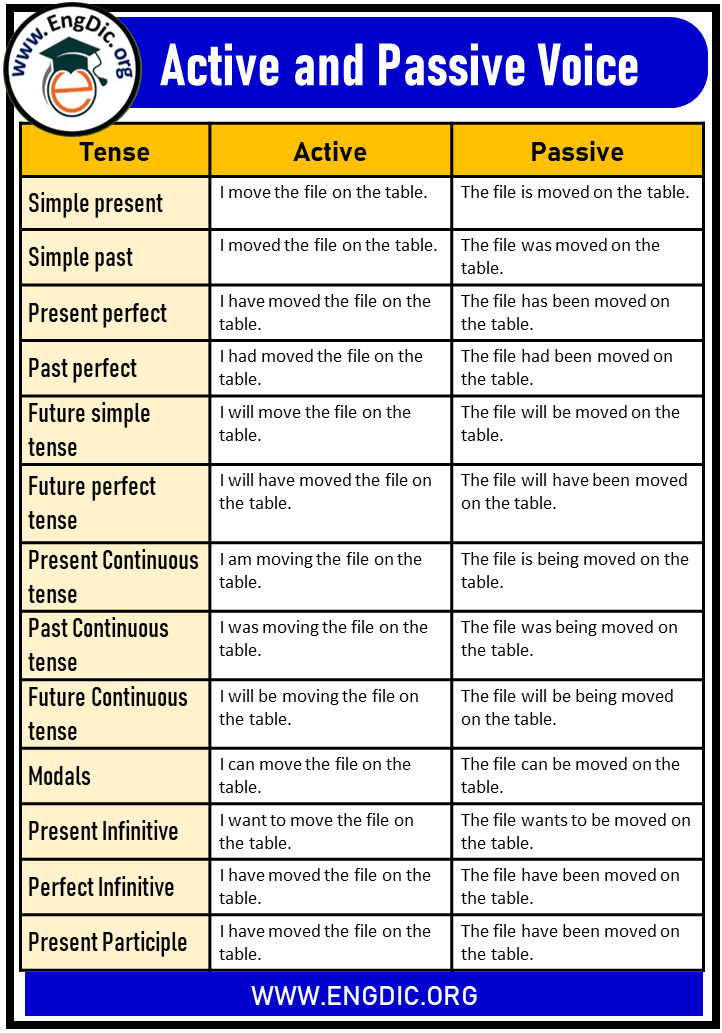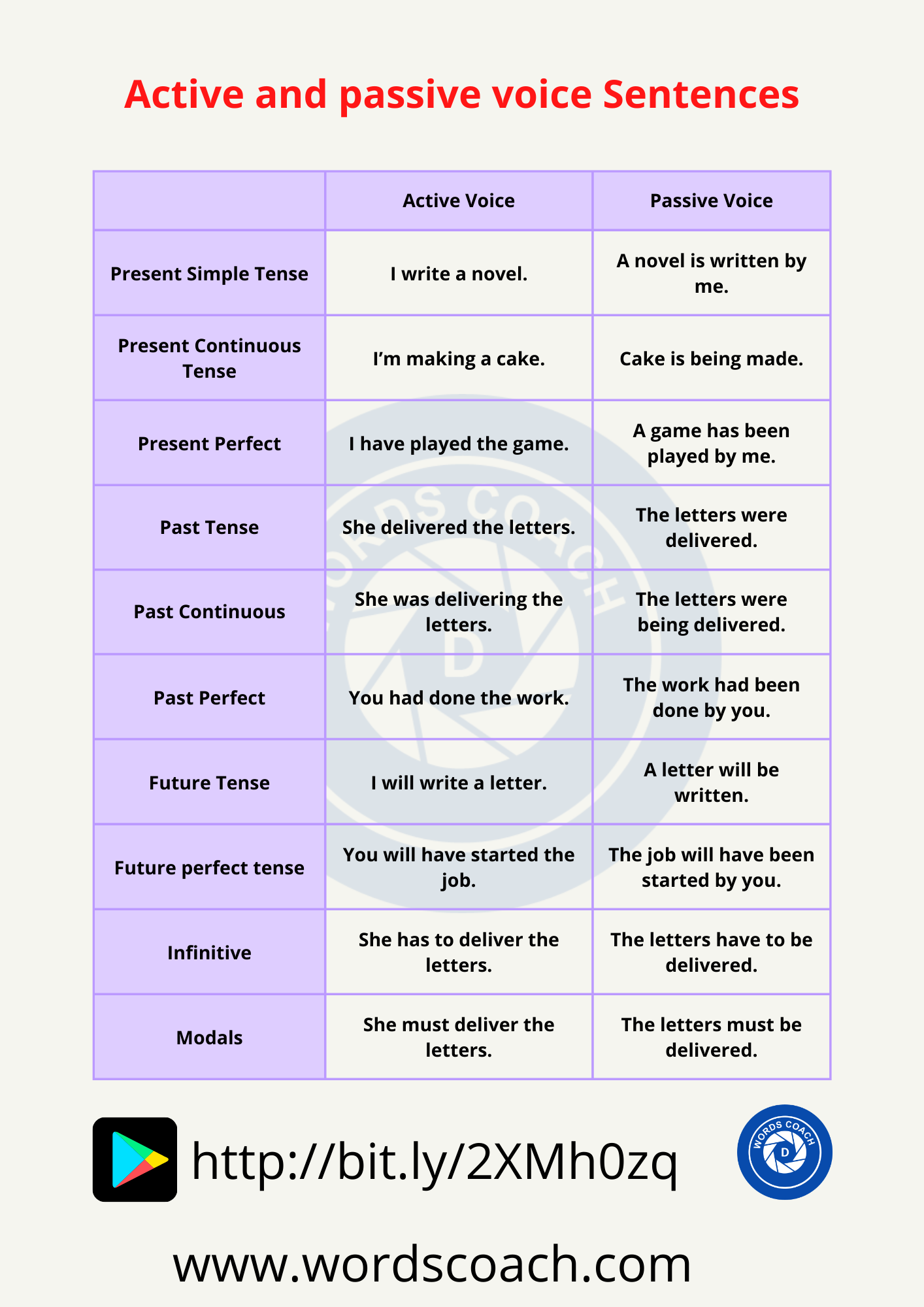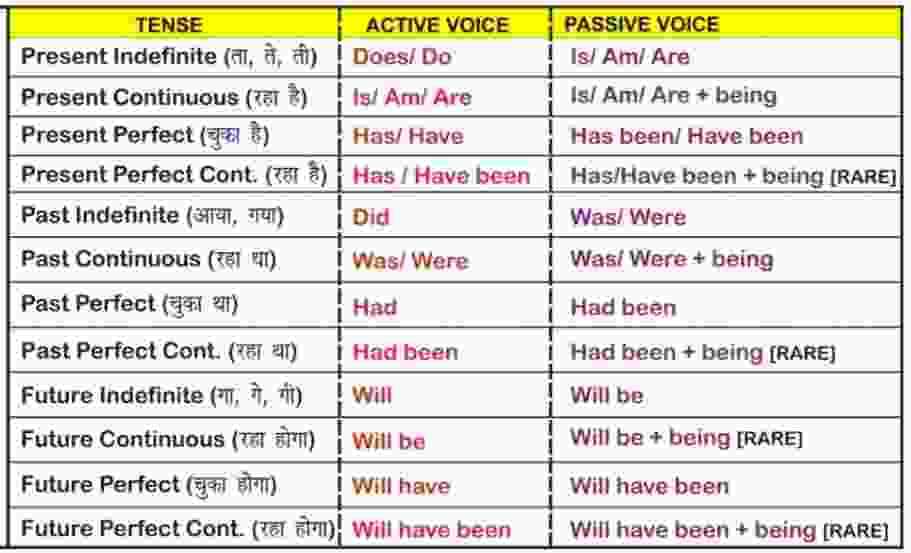
100 Examples of Active and Passive Voice (All Tenses) EngDic
The active voice, in a sentence, denotes that the noun or pronoun that acts as the subject in the sentence is the doer of the action. In other words, the subject performs the action or acts upon the verb.

Passive Chart
Structure: (Object will be replaced by Subject+ auxiliary verb according to the tense+ past participle form of the main verb+ by+ Subject will be replaced by Object+ extra) For Examples, Active: Your friend likes my job because of privacy. Passive: My job is liked by your friend because of privacy .

learn about the active and passive voice in english here on Englishvid English Grammar Notes
An active construction is preferable for clarity and concision. The CEO made the decision to close the factory. If you write a passive sentence, consider carefully whether leading with the actor would strengthen your point. This is also relevant when discussing previous research: active constructions that specify who is responsible for findings.

Breanna Voice Structure Active And Passive Voice Formula Chart Images and Photos finder
Active Voice: subject + verb + object. Passive Voice: object + to be + past participle verb + subject (optional) Interchanging the object and subject determines if a sentence is active or passive. Active Voice: The dog (subject) jumped over the fence (object). Passive Voice: The fence (object) was jumped over by the dog (subject).

ACTIVE VOICE AND PASSIVE VOICE UG English
English Grammar Verbs Active and passive voice Active and passive voice Level: beginner Transitive verbs have both active and passive forms: Passive forms are made up of the verb be with a past participle: If we want to show the person or thing doing the action, we use by: She was attacked by a dangerous dog. The money was stolen by her husband.

Active and Passive Voice Examples AdrianteEllison
The active voice emphasizes the subject, or the thing performing the action. The passive voice, on the other hand, emphasizes the action or the recipient of the action. Schools typically teach students to avoid the passive voice whenever possible. This is because sentences in active voice tend to be stronger and more concise.

Passive Voice Бесплатные распечатки, Образование, Английский
Active and Passive voice is a particularly essential grammatical structure used in the English language. Understanding the rules governing their usage is crucial for effective communication.In this article, we will delve into the fundamentals of the active and passive voice. we will also explore the usage, rules, and conversion of Active and Passive voices.

active and passive voice rules chart Google Search Active and passive voice, The voice
Rule-3(active and passive voice rules) The rule of passive from the active voice of imperative sentence: Rules for converting active voice to passive voice, starting with the main verb only-Structure: Let+Object will be subject.+Be+ main verb will be past participle form. Examples are-Active: Do the work. Passive: Let the work be done.

Active And Passive Voice Examples For All Tenses Table of Contents Active And Passive Voice
The active voice is a style of writing where the subject acts upon its verb. Here, the subject always comes first, followed by the verb and the complements. The active voice is so called because, unlike the passive voice where the subject is passive, the subject here is active. Example Sentences with Active Voice Andrew hit the ball.

SOAL ACTIVE PASSIVE SENTENCES KELAS XI
Here is a quick overview of the active and passive voice verb forms. Verb form: first form of the verb They speak English here. He speaks English. Verb form: is / am / are + past participle form of the verb English is spoken here. English is spoken by him. Present continuous tense Verb form: is/am/are + -ing form of the verb

50+ Sentences of active and passive voice Word Coach
There are times when passive voice is useful and called for. For example, "The squirrel was chased by the dog". The sentence construction would be helpful if the squirrel were the focus of our writing and not the dog. Structure of Active and Passive Voice . Active voice describes a sentence where the subject is the doer of an action.

Active and Passive Voice Examples with Answers English Study Here
Active: The award-winning chef prepares each meal with loving care. Passive: Each meal is prepared with loving care by the award-winning chef. In the above example of an active sentence, the simple subject is "chef" and "prepares" is the verb: the chef prepares "each meal with loving care."

The Passive Voice Important Rules and Examples курсы 8 Английский язык, Изучать английский
The past passive form follows this pattern: modal + have been + past participle Active: SHOULD HAVE / SHOULDN'T HAVE The students should have learned the verbs. The children shouldn't have broken the window. Passive: SHOULD HAVE / SHOULDN'T HAVE The verbs should have been learned by the students. The window shouldn't have been

online learning,education online,courses online,education online technology edu Teaching
An active construction is preferable for clarity and concision. The CEO made the decision to close the factory. If you write a passive sentence, consider carefully whether leading with the actor would strengthen your point. This is also relevant when discussing previous research: active constructions that specify who is responsible for findings.

Active And Passive Voice Examples For All Tenses Table Of Contents Images
Passive voice: Interviews are being taken for different posts (by them). Active voice: The police are interrogating him right now. Passive voice: He is being interrogated (by the police) right now. Active voice: Everyone is praising your work. Passive voice: Your work is being praised by everyone.

Active And Passive Voice With Tenses, Example Sentences B6B Tenses Chart, All Tenses, Verb
Active and Passive Voice: You know that every subject has a subject, a verb, and an object. A subject is an agent who performs the verb on the object. Let's understand this with the help of an example: I swim in the ocean. - I is the subject, swim is the verb, and ocean is the object. My mom plays violin.